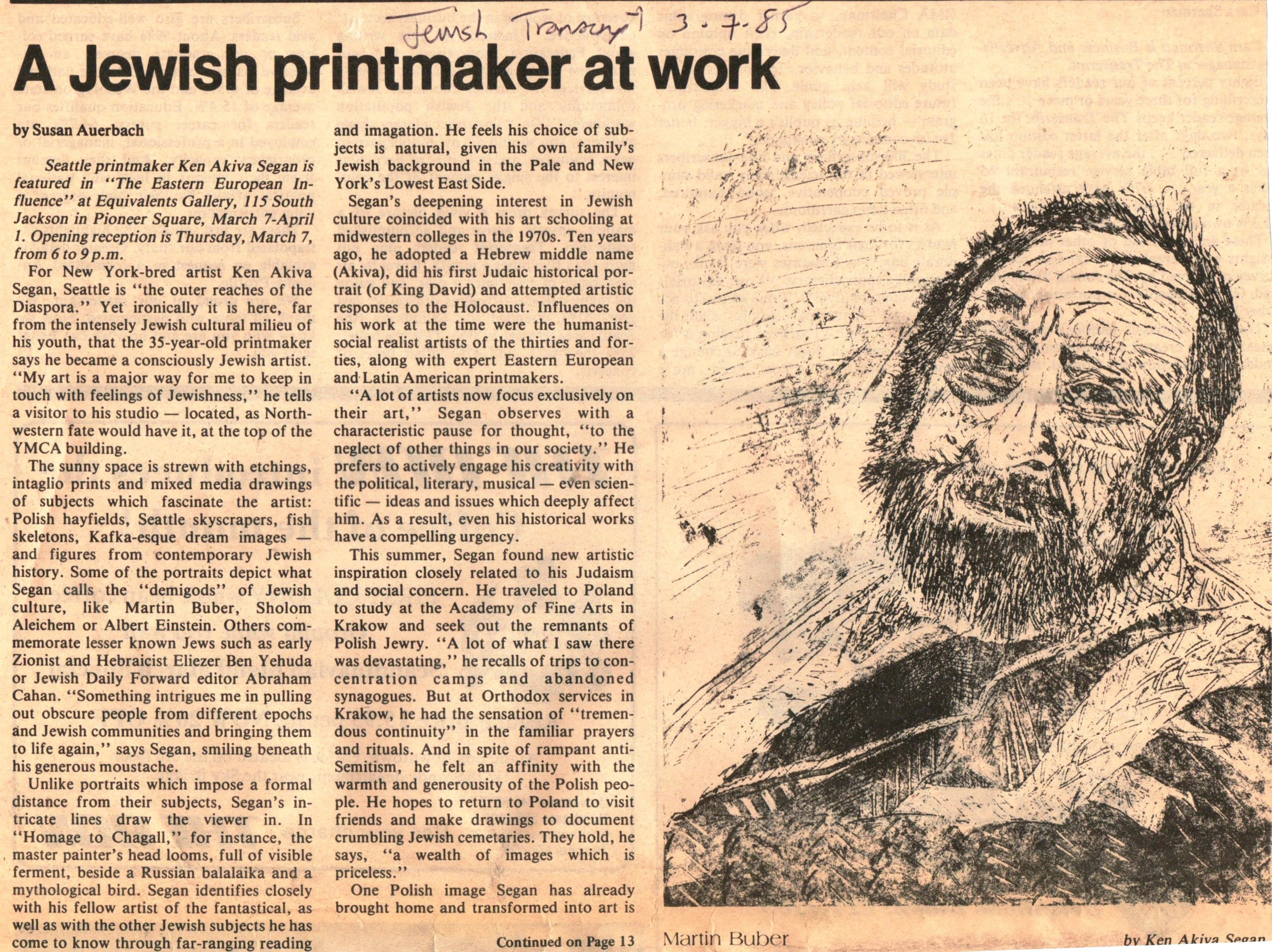The Jewish Transcript
Volume LXI, No. 5, Seattle, Washington / © Pub. No. ISSN 0021-678X
March 7, 1985 | 14 Adar 5745
ART & ENTERTAINMENT
A Jewish printmaker at work, by Susan Auerbach
Seattle printmaker Ken Akiva Segan is featured in “The Eastern European Influence” at Equivalents Gallery, 115 South Jackson in Pioneer Square, March 7-April 1. Opening reception is Thursday, March 7, from 6-9 p.m.
For New York-bred artist Ken Akiva Segan, Seattle is “the outer reaches of the Diaspora.” Yet ironically it is here, far from the intensely Jewish cultural milieu of his youth, that the 35-year old says he became a consciously Jewish artist. “My art is a way for me to keep in touch with feelings of Jewishness,” he tells a visitor to his studio – located, as Northwestern fate would have it, at the top of the YMCA building.
The sunny space is strewn with etchings, intaglio prints and mixed media drawings of subjects which fascinate the artist: Polish hayfields, Seattle skyscrapers, fish skeletons, Kafka-esque dreams images – and figures from contemporary Jewish history. Some of the portraits depict what Segan calls the “demigods” of Jewish culture, like Martin Buber, Sholom Aleichem or Albert Einstein. Others commemorate lesser known Jews such as early Zionist and Hebraicist Eliezer ben Yehuda or Jewish Daily Forward editor Abraham Cahan. “Something intrigues me in pulling out obscure people from different epochs and bringing them to life again,” Segan says, smiling beneath his generous moustache.
Unlike portraits which impose a formal distance from their subjects, Segan’s intricate lines draw the viewer in. In “Homage to Chagall,” for instance, the master painter’s head looms, full of visible ferment, beside a Russian balalaika and a mythological bird. Segan identifies closely with his fellow artist of the fantastical, as well as with the other Jewish subjects he has come to know through far-ranging reading and imagination. He feels his choice of subjects is natural, given his own family’s Jewish background in the Pale and New York’s Lowest East Side.
Segan’s deepening interest in Jewish culture coincided with his art schooling in midwestern colleges in the 1970’s. Ten years ago, he adopted a Hebrew middle name (Akiva), did his first Judaic historical portrait (of King David) and attempted artistic responses to the Holocaust. Influences on his work at the time were the humanist-social realist artists of the thirties and forties, along with expert Eastern European and Latin American printmakers.
“A lot of artists now focus exclusively on their art,” Segan observes with a characteristic pause for thought, “to the neglect of other things in our society.” He prefers to actively engage his creativity with the political, literary, musical – even scientific – ideas and issues which deeply affect him. As a result, even his historical works have a compelling urgency.
This summer, Segan found new artistic inspiration closely related to his Judaism and social concerns. He traveled to Poland to study at the Academy of Fine Arts in Krakow and seek out the remnants of Polish Jewry. “A lot of what I saw there was devastating,” he recalls of trips to concentration camps and abandoned synagogues. But at Orthodox services in Krakow, he had the sensation of “tremendous continuity” in the familiar prayers and rituals. And in spite of rampant anti-Semitism, he felt an affinity with the warmth and generosity of the Polish people. He hopes to return to Poland to visit friends and make drawings to document crumbling Jewish cemeteries. They hold, he says, a “wealth of images which is priceless.”
One Polish image Segan has already brought home and transformed into art is called “Homage to Pawiak Prison.” The work memorializes five political prisoners executed at the notorious Warsaw prison before its destruction by the Nazis in 1994. Their portraits are attached to an angular wooden base, crossed by a dense, interconnecting web of colored threads in a new mixed media venture for Segan.
Not all of Segan’s works, old or new, are so intense. Like the dark, wiry artist himself, they can also radiate fantasy and whimsy. Favored creatures like fish and birds, and even the Yiddish exclamation “feh!” find their way into faces and landscapes. A fanciful “King of the Beasts” sprouts several horns and tails in deep maroon, teal blue and gold against a mottled brown background. Segan plays with poetic license in titles like “Dream! Oh Dream! Of Sailing Ships and Shining Seas! Yes, Indeed!”
His diverse work reveals Segan’s fascination not only with Judaica but with architecture, map-making, music and even entymology. His visions of Seattle buildings are exhibited in several works, the clean colorful lines of the drawings often an improvement on the original. The etching “Archaic Forms” is reminiscent of a shipmaker’s blueprint….or could it be a stained antique treasure map, or hieroglyphics?
“People find things in my work I didn’t even know existed,” Segan says with modest wonder. The complexity of the etched lines invites searching and speculation.
Like many of his fellow artists, Segan has had to work a ‘real’ job (in the Seattle Public Library Art Dept.) to support his printmaking. Yet in less than ten years, he has managed to amass an impressive resume: his varied works can be found in collections around the U.S., Israel and Europe.
[Reproduction: Etching of “Martin Buber”]
